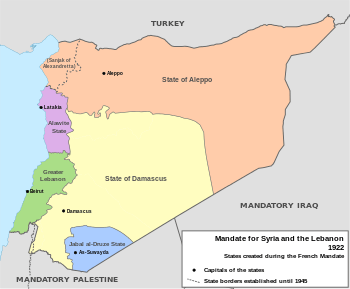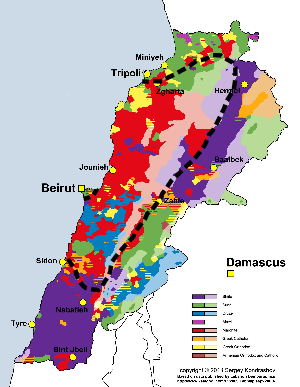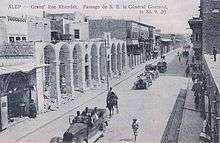French Mandate for Syria and the Lebanon
| French Mandate for Syria and Lebanon (1923−1946) | |
|---|---|
 Front cover of the Mandate document, 1922. | |
| Created | 1920–1922 |
| Ratified | 1923 |
| Signatories | League of Nations |
| Purpose |
Creation of |
Officially, the Mandate for Syria and the Lebanon (French: Mandat français pour la Syrie et le Liban) (1923−1946),[1] was a League of Nations mandate founded after the First World War and the partitioning of the Ottoman Empire concerning Syria and the Lebanon. The Mandate system was considered to be the antithesis to colonialism, with the governing country acting as a trustee until the inhabitants would be able to stand on their own. At that point, the Mandate would terminate and an independent state would be born.[2]
During the two years that followed the end of the war in 1918 – and in accordance with the Sykes-Picot Agreement that was signed between Britain and France during the war – the British held control of most Ottoman Mesopotamia (modern Iraq) and the southern part of the Ottoman Syria (Palestine and Transjordan), while the French controlled the rest of Ottoman Syria, Lebanon, Alexandretta (Hatay) and other portions of southeastern Turkey. In the early 1920s, British and French control of these territories became formalized by the League of Nations' mandate system, and France was assigned the League of Nations mandate of Syria on 29 September 1923, which included the territory of present-day Lebanon and Alexandretta in addition to Syria proper.
The administration of the region under the French was carried out through a number of different governments and territories, including the Syrian Federation (1922–24), the State of Syria (1924–30) and the Syrian Republic (1930–1958), as well as the smaller states of the State of Greater Lebanon, the Alawite State and Jabal Druze State. The French mandate of Syria lasted until 1943, when two independent countries emerged from the mandate period, Syria and Lebanon, in addition to Hatay, which was annexed by Turkey in 1939. French troops completely left Syria and Lebanon in 1946.
Background
With the defeat of Ottomans in Syria, British troops, under General Sir Edmund Allenby, entered Damascus in 1918 accompanied by troops of the Arab Revolt led by Faisal, son of Sharif Hussein of Mecca.
Faisal established the first Arab government in Damascus in October 1918, and named Ali Rida Pasha ar-Rikabi a military governor.

The new Arab administration formed local governments in the major Syrian cities, and the pan-Arab flag was raised all over Syria. The Arabs hoped, with faith in earlier British promises, that the new Arab state would include all the Arab lands stretching from Aleppo in northern Syria to Aden in southern Yemen.
However, in accordance with the secret Sykes–Picot Agreement between Britain and France, General Allenby assigned to the Arab administration only the interior regions of Syria (the eastern zone). Palestine (the southern zone) was reserved for the British. On 8 October, French troops disembarked in Beirut and occupied the Lebanese coastal region south to Naqoura (the western zone), replacing British troops there. The French immediately dissolved the local Arab governments in the region.
France demanded full implementation of the Sykes–Picot Agreement, with Syria under its control. On 26 November 1919, British forces withdrew from Damascus to avoid confrontation with the French, leaving the Arab government to face France.
Faisal had traveled several times to Europe, beginning in November 1918, trying to convince France and Britain to change their positions, but without success. France's determination to intervene in Syria was shown by the naming of General Henri Gouraud as high commissioner in Syria and Cilicia.
At the Paris Peace Conference, Faisal found himself in an even weaker position when the European powers decided to ignore the Arab demands.
In June 1919, the American King–Crane Commission arrived in Syria to inquire about the local public opinion regarding the future of the country. The commission's workspace extended from Aleppo to Beersheba. They visited 36 major cities, met with more than 2,000 delegations from more than 300 villages, and received more than 3,000 petitions. Their conclusions confirmed the opposition of Syrians to the mandate in their country as well as to the Balfour Declaration, and their demand of a unified Greater Syria encompassing Palestine. The conclusions of the commission were rejected by France and ignored by Britain.
In May 1919, elections were held for the Syrian National Congress, which convened in Damascus. 80% of seats went to conservatives. However, the minority included dynamic Arab nationalist figures such as Jamil Mardam Bey, Shukri al-Kuwatli, Ahmad al-Qadri, Ibrahim Hanano, and Riyad as-Solh. The head was moderate nationalist Hashim al-Atassi.
Unrest erupted in Syria when Faisal accepted a compromise with French Prime Minister Clemenceau and Zionist leader Chaim Weizmann over the issue of Jewish immigration to Palestine. Anti-Hashemite manifestations broke out, and Muslim inhabitants in and around Mount Lebanon revolted with fear of being incorporated into a new, mainly Christian, state of Greater Lebanon. A part of France's claim to these territories in the Levant was that France was a protector of the minority Christian communities.
In March 1920, the Congress in Damascus adopted a resolution rejecting the Faisal-Clemenceau accords. The Congress declared the independence of Syria in her natural borders (including Southern Syria or Palestine), and proclaimed Faisal the king of all Arabs. The congress also proclaimed political and economic union with neighboring Iraq and demanded its independence as well.
On 25 April, the supreme inter-Allied council, which was formulating the Treaty of Sèvres, granted France the mandate of Syria (including Lebanon), and granted Britain the Mandate of Palestine (including Jordan), and Iraq. Syrians reacted with violent demonstrations, and a new government headed by Ali Rida al-Rikabi was formed on 9 May 1920. The new government decided to organize general conscription and began forming an army.
These decisions provoked adverse reactions by France as well as by the Maronite patriarchate of Mount Lebanon, which denounced the decisions as a "coup d'état". In Beirut, the Christian press expressed its hostility to the decisions of Faisal's government. Lebanese nationalists used the crisis to convene a council of Christian figures in Baabda that proclaimed the independence of Lebanon on 22 March 1920.
On 14 July 1920, General Gouraud issued an ultimatum to Faisal, giving him the choice between submission or abdication. Realizing that the power balance was not in his favor, Faisal chose to cooperate. However, the young minister of war, Youssef al-Azmeh, refused to comply. In the resulting Franco-Syrian War, Syrian troops under al-Azmeh met French forces under General Mariano Goybet at the Battle of Maysaloun. The French won the battle in less than a day. Azmeh died on the battlefield along with many of the Syrian troops. Goybet entered Damascus on 24 July 1920. The Mandate was written in London on 24 July 1922.[2]
States created during the French Mandate
.svg.png)

When first arriving in Lebanon, the French were received as liberators by the Christian community, but as they were entering Syria, they were faced with a strong resistance.
The mandate region was subdivided into six states. They were the states of Damascus (1920), Aleppo (1920), Alawites (1920), Jabal Druze (1921), the autonomous Sanjak of Alexandretta (1921, modern-day Hatay), and the State of Greater Lebanon (1920), which became later the modern country of Lebanon.
The drawing of those states was based in part on the sectarian makeup on the ground in Syria. However, nearly all the Syrian sects were hostile to the French mandate and to the division it created. This was best demonstrated by the numerous revolts that the French encountered in all of the Syrian states. Maronite Christians of Mount Lebanon, on the other hand, were a community with a dream of independence that was being realized under the French; therefore, Greater Lebanon was the exception to the newly formed states.
It took France three years from 1920 to 1923 to hold full control over Syria and to quell all the insurgencies that broke out, notably in the Alawite territories, Mount Druze and Aleppo.
Although there were uprisings in the respective states, the French purposefully gave different ethnic and religious groups in the Levant their own lands in the hopes of prolonging their rule. During this time of world decolonization, the French had hoped to focus on fragmenting the various groups in the region, in the hopes that the local population would not focus on a larger nationalist movement to dispose of colonial rule. To add to this, administration of colonial governments was heavily dominated by the French. Local authorities were given very little power and did not have the authority to independently decide policy. The small amount of power that local leaders had could easily be over-ruled by French officials. The French did everything in their power to prevent people in the Levant from developing self-sufficient governing bodies. In 1930, France extended their constitution on to Syria. [3]
| Diagram of states under the Mandate | |||||||||||||||||||||||||||||||||||||||||||||||||||||||||||||||||||||||||||||||||||||||||||||||||||||||||||||||||||||||||||||||||||||||||||||||||||||||||||||||||||||||||||||||||||||||||||||||||||||||||||||||||||||||||||||||||||||||||||||||||||||||||||||||||||||||||||||||||||||||||||||||||||||||||||||||||||||||||||||||||||||||||||||||||||||||||||||||||||||||||||||||||||||||||||||||||||||||||||||||||||||||||||||||||||||||||||||||||||||||||||||||||||||||||||||||||||||||||||||||||||||||||||||||||||||||||||||||||||||||||||||||||||||||||||||||||||||||||||
|---|---|---|---|---|---|---|---|---|---|---|---|---|---|---|---|---|---|---|---|---|---|---|---|---|---|---|---|---|---|---|---|---|---|---|---|---|---|---|---|---|---|---|---|---|---|---|---|---|---|---|---|---|---|---|---|---|---|---|---|---|---|---|---|---|---|---|---|---|---|---|---|---|---|---|---|---|---|---|---|---|---|---|---|---|---|---|---|---|---|---|---|---|---|---|---|---|---|---|---|---|---|---|---|---|---|---|---|---|---|---|---|---|---|---|---|---|---|---|---|---|---|---|---|---|---|---|---|---|---|---|---|---|---|---|---|---|---|---|---|---|---|---|---|---|---|---|---|---|---|---|---|---|---|---|---|---|---|---|---|---|---|---|---|---|---|---|---|---|---|---|---|---|---|---|---|---|---|---|---|---|---|---|---|---|---|---|---|---|---|---|---|---|---|---|---|---|---|---|---|---|---|---|---|---|---|---|---|---|---|---|---|---|---|---|---|---|---|---|---|---|---|---|---|---|---|---|---|---|---|---|---|---|---|---|---|---|---|---|---|---|---|---|---|---|---|---|---|---|---|---|---|---|---|---|---|---|---|---|---|---|---|---|---|---|---|---|---|---|---|---|---|---|---|---|---|---|---|---|---|---|---|---|---|---|---|---|---|---|---|---|---|---|---|---|---|---|---|---|---|---|---|---|---|---|---|---|---|---|---|---|---|---|---|---|---|---|---|---|---|---|---|---|---|---|---|---|---|---|---|---|---|---|---|---|---|---|---|---|---|---|---|---|---|---|---|---|---|---|---|---|---|---|---|---|---|---|---|---|---|---|---|---|---|---|---|---|---|---|---|---|---|---|---|---|---|---|---|---|---|---|---|---|---|---|---|---|---|---|---|---|---|---|---|---|---|---|---|---|---|---|---|---|---|---|---|---|---|---|---|---|---|---|---|---|---|---|---|---|---|---|---|---|---|---|---|---|---|---|---|---|---|---|---|---|---|---|---|---|---|---|---|---|---|---|---|---|---|---|---|---|---|---|---|---|---|---|---|---|---|---|---|---|---|---|---|---|---|---|---|---|---|---|---|---|---|---|---|---|---|---|---|---|---|---|---|---|---|---|---|---|---|---|---|---|---|---|---|---|---|---|---|---|---|---|---|---|---|---|---|---|---|---|---|---|---|---|---|---|---|---|---|---|---|---|---|---|---|---|---|---|---|---|---|---|---|---|---|---|---|---|---|---|---|---|---|---|---|---|---|---|---|---|---|---|---|
| |||||||||||||||||||||||||||||||||||||||||||||||||||||||||||||||||||||||||||||||||||||||||||||||||||||||||||||||||||||||||||||||||||||||||||||||||||||||||||||||||||||||||||||||||||||||||||||||||||||||||||||||||||||||||||||||||||||||||||||||||||||||||||||||||||||||||||||||||||||||||||||||||||||||||||||||||||||||||||||||||||||||||||||||||||||||||||||||||||||||||||||||||||||||||||||||||||||||||||||||||||||||||||||||||||||||||||||||||||||||||||||||||||||||||||||||||||||||||||||||||||||||||||||||||||||||||||||||||||||||||||||||||||||||||||||||||||||||||||
State of Greater Lebanon


On 1 September 1920, General Gouraud proclaimed the establishment of the State of Greater Lebanon (French: État du Grand Liban, Arabic: دولة لبنان الكبير).
Greater Lebanon was created by France to be a "safe haven" for the Maronite population of the mutasarrifia (Ottoman administrative unit) of Mount Lebanon. Mt. Lebanon, an area with a Maronite majority, had enjoyed variable degrees of autonomy during the Ottoman era. However, in addition to the Maronite Mutasarrifia other, mainly Muslim, regions were added, forming "Greater" Lebanon. Those regions correspond today to North Lebanon, south Lebanon, Biqa' valley, and Beirut. The capital of Greater Lebanon was Beirut. The new state was granted a flag merging the French flag with the cedar of Lebanon.
Most of the Muslims in Greater Lebanon rejected the new state upon its creation. Some believe that the Muslim continuous demand for reunification with Syria eventually brought about an armed conflict between Muslims and Christians in 1958 when Lebanese Muslims wanted to join the newly proclaimed United Arab Republic, while Lebanese Christians were strongly opposed. However, most members of the Lebanese Muslim communities and their political elites were already committed to the idea of being Lebanese citizens since the late 1930s, even though they also tended to nurture Arab nationalist sentiments.
Maronites were the majority in Lebanon and managed to preserve its independence; an independence that created a unique precedent in the Arab world as Lebanon was the first Arab country in which Christians were not a minority. The State of Greater Lebanon existed until 23 May 1926, after which it became the Lebanese Republic.
State of Alawites
The State of Alawites (French: État des Alaouites, Arabic: دولة العلويين) was located on the Syrian coast and incorporated a majority of Alawites, a branch of Shia Islam. The port city of Latakia was the capital of this state. Initially it was an autonomous territory under French rule known as the "Alawite Territories". It became part of the Syrian Federation in 1922, but left the federation again in 1924 and became the "State of Alawites". On 22 September 1930, it was renamed the "Independent Government of Latakia". The population at this time was 278,000. The government of Latakia finally joined the Syrian Republic on 5 December 1936.
This state witnessed several rebellions against the French; some of the most prominent ones were under Salih al-Ali, an Alawite anti-French figure.
State of Jabal Druze
The State of Jabal Druze was a French mandate from 1921 to 1936 created for the Druze population of southern Syria. It had a population of some 50,000 and had its capital in As-Suwayda.
State of Aleppo

The State of Aleppo (1920–1925, French: État d'Alep, Arabic: دولة حلب) included a majority of Sunni Muslims. It covered northern Syria in addition to the entire fertile basin of river Euphrates of eastern Syria. These regions represented much of the agricultural and mineral wealth of Syria. The autonomous Sanjak of Alexandretta was added to the state of Aleppo in 1923.
The capital was the northern city of Aleppo, which had large Christian and Jewish communities in addition to the Sunni Muslims. The state also incorporated minorities of Shiites and Alawites. Ethnic Kurds and Assyrians inhabited the eastern regions alongside the Arabs.
The primarily Sunni population of the state of Aleppo was strongly opposed to the division of Syria. This resulted in its quick end in 1925, when France united the states of Aleppo and Damascus into the State of Syria.
State of Damascus
The State of Damascus was a French mandate from 1920 to 1925. The capital was Damascus.
Sanjak of Alexandretta
The Sanjak of Alexandretta became an autonomous province of Syria under Article 7 of the French-Turkish treaty of 20 October 1921: "A special administrative regime shall be established for the district of Alexandretta. The Turkish inhabitants of this district shall enjoy facility for their cultural development. The Turkish language shall have official recognition".[6]
In 1923, Alexandretta was attached to the State of Aleppo, and in 1925 it was directly attached to the French mandate of Syria, still with special administrative status. The sanjak was given autonomy in November 1937 in an arrangement brokered by the League. Under its new statute, the sanjak became 'distinct but not separated' from the French Mandate of Syria on the diplomatic level, linked to both France and Turkey for defence matters.
In 1938, the Turkish military went into the Syrian province and expelled most of its Arab and Armenian inhabitants.[7] Before this, Alawi Arabs and Armenians were the majority of Alexandretta's population.[7]
The allocation of seats in the sanjak assembly was based on the 1938 census held by the French authorities under international supervision. The assembly was appointed in the summer of 1938, and the French-Turkish treaty settling the status of the Sanjak was signed on 4 July 1938.
On 2 September 1938, the assembly proclaimed the Sanjak of Alexandretta as the Hatay State, taking as an excuse that rioting had broken out between Turks and Arabs. The republic lasted for one year under joint French and Turkish military supervision. The name Hatay itself was proposed by Atatürk and the government was under Turkish control. In 1939, following a popular referendum, the Hatay State became a Turkish province.
Demands for secession not granted by the French Mandate authorities
Al-Jazira Province
In 1936–1937, there was some autonomist agitation among Assyrians and Kurds, supported by some Bedouins, in the province of Al-Jazira. Its partisans wanted the French troops to stay in the province in the hypothesis of a Syrian independence, as they feared the nationalist Damascus government would replace minority officials by Muslim Arabs from the capital. The French authorities refused to consider any new status of autonomy inside Syria.[8][9][10]
Golan Region
In Quneitra and the Golan Region, there was a sizeable Circassian community. Several Circassian leaders wanted in 1938, for the same reasons as their Assyrian, Kurdish and Bedouin counterparts in Al-Jazira province in 1936–1937, a special autonomy status for their region, as they feared the perspective of living in an independent Syrian republic under a nationalist Arab government hostile towards the minorities. They also wanted the Golan region to become a national homeland for Circassian refugees from the Caucasus. A Circassian battalion served in the French Army of the Levant and had helped it against the Arab nationalist uprisings. Like in Al-Jazira Province, the French authorities refused to grant any autonomy status to the Golan Circassians.[11]
See also
- French Colonial Empire
- French colonial flags
- French Lebanese
- List of French possessions and colonies
- Modern history of Syria
- Roman Syria
Notes
- ↑ League of Nations Official Journal, Vol 3, August 1922, p. 1013
- 1 2 Bentwich, Norman (1930). The Mandates System. Longmans, Green and Co. p. 172.
- ↑ William Cleveland, A History of the Modern Middle East, 5th edition (Westview, 2012
- ↑ The Origins of the Lebanese National Idea: 1840–1920, Carol Hakim, p. 287
- ↑ Inventing Lebanon: Nationalism and the State Under the Mandate, Kais Firro, p18
- ↑ Sarah D. Shields, Fezzes in the River: Identity Politics and European Diplomacy in the Middle East on the Eve of World War II, 2011
- 1 2 Jack Kalpakian (2004). Identity, Conflict and Cooperation in International River Systems (Hardcover ed.). Ashgate Publishing. p. 130. ISBN 0-7546-3338-1.
- ↑ La situation des chrétiens de Syrie après les affaires de Djézireh, November 1937, Centre d'Études et d'Administration Musulmanes (CHEAM), Paris
- ↑ Virginia Vacca, "La questione dell'el-Ǧezīrah secondo il memoriale del Partito Comunista Siriano", Oriente Moderno, 1938, 18, pp. 197–211
- ↑ Jordi Tejel Gorgas, "Les territoires de marge de la Syrie mandataire : le mouvement autonomiste de la Haute Jazîra, paradoxes et ambiguïtés d’une intégration « nationale » inachevée (1936–1939)" (The territory margins of the Mandatory Syria: the autonomist movement in Upper Jazîra, paradoxs and ambiguities of an uncompleted "national" integration, 1936–39), Revue des mondes musulmans et de la Méditerranée, 126, November 2009, pp. 205–222
- ↑ M. Proux, "Les Tcherkesses", La France méditerranéenne et africaine, IV, 1938
External links
| Wikisource has original text related to this article: |
- David Kenneth Fieldhouse (2006). Western Imperialism in the Middle East 1914–1958.
- Sami M. Moubayed (2006). Steel & silk:men and women who shaped Syria 1900–2000.
- Derek Hopwood (1988). Syria 1945–1986:politics and society.
- Timeline of the French Mandate period
- Mandat Syria-Liban ... (1920–1946)
- La Syrie et le mandat français (1920–1946)
- Les Relations franco-libanaises dans le cadre des relations Internationales
- Mandat français au Proche-Orient at the Wayback Machine (archived 16 July 2006)
- "No Yo-Yo!". Time. 30 January 1933. Retrieved 19 August 2009.
.svg.png)
